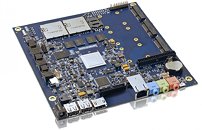Friday, July 13th 2012

Tegra Completes its Long Walk to the PC, Courtesy Kontron
You could soon have NVIDIA Tegra 3 processors running entry-level PCs. COM (computer-on-module) and IPC (industrial PC) designer Kontron developed an NVIDIA Tegra 3 system board in the slim mini-ITX form-factor (170 mm x 170 mm), which is compatible with most ITX/ATX cases. The board has most common PC peripheral interfaces, and is fit to drive an entry-level PC. The KTT30/mITX from Kontron features an NVIDIA Tegra 3 SoC, with 4+1 ARM Cortex-A9 cores clocked at 900 MHz and GeForce ULP graphics. The GPU is fit to drive 1080p displays with H264 MPEG-4 encoding/decoding acceleration. Display outputs include HDMI 1.4a (up to 1920x1080 pixels), and LVDS 24-bit (up to 2048x1536 pixel @ 18bpp).
The Kontron KTT30/mITX packs 2 GB of DDR3L memory. For storage, it has an mSATA 3 Gb/s port, two SD card slots, and a bootable eMMC slot. Two mPCIe slots and a SIM card slot (for 3G HSDPA) handle on-board expansion. System interfaces include two RS232 (serial/COM), three USB 2.0. Apart from 3G HSDPA, the board supports gigabit Ethernet. For audio, there's 2-channel analog and multi-channel digital (S/PDIF) audio outputs. The board draws power from a 2-pin DC input. The board should be able to run most distributions of Linux for ARM (including Android and Chrome OS), and technically should also be able to run the upcoming Microsoft Windows 8 RT operating system.
Sources:
Blogeee.net, FanlessTech
The Kontron KTT30/mITX packs 2 GB of DDR3L memory. For storage, it has an mSATA 3 Gb/s port, two SD card slots, and a bootable eMMC slot. Two mPCIe slots and a SIM card slot (for 3G HSDPA) handle on-board expansion. System interfaces include two RS232 (serial/COM), three USB 2.0. Apart from 3G HSDPA, the board supports gigabit Ethernet. For audio, there's 2-channel analog and multi-channel digital (S/PDIF) audio outputs. The board draws power from a 2-pin DC input. The board should be able to run most distributions of Linux for ARM (including Android and Chrome OS), and technically should also be able to run the upcoming Microsoft Windows 8 RT operating system.

24 Comments on Tegra Completes its Long Walk to the PC, Courtesy Kontron
Does Kontron actually claim it will be able to run Windows 8 RT or is it exactly as said "technically should"?
Also, pricing?
^ I see one IDE, Maybe a possible floppy
The smaller one is LVDS i think.
LVDS is probably right.
2x RS232 (1x 8wire RS232 port and 1x port which can be used either as cc-talk or 4wire RS232)
24 bit LVDS (up to 2048x1536 pixel @ 18bpp) and DSI (up to 1440x900 @ 18bpp)
Touch screen connector, Feature connector - 18x GPIOs, 3 MIPI connectors (1x DSI, 1x CSI,
1x either DSI oder CSI)
There you go, that's all the pin headers in the board.
It is an interesting product nevertheless and hopefully a sign of things to come. I have predicted something like this (but with a more powerful CPU such as the quad core Snapdragon which is suppsoed to run at 1.7 GHz and with much better GPU built-in) to emerge in the near future. If priced reasonably (as in: targeting your average mom&pop computer users rather than industrial users) it could sell very well ... if not some other similar product will skim the cream from being first to the non-x86 PC consumer market.